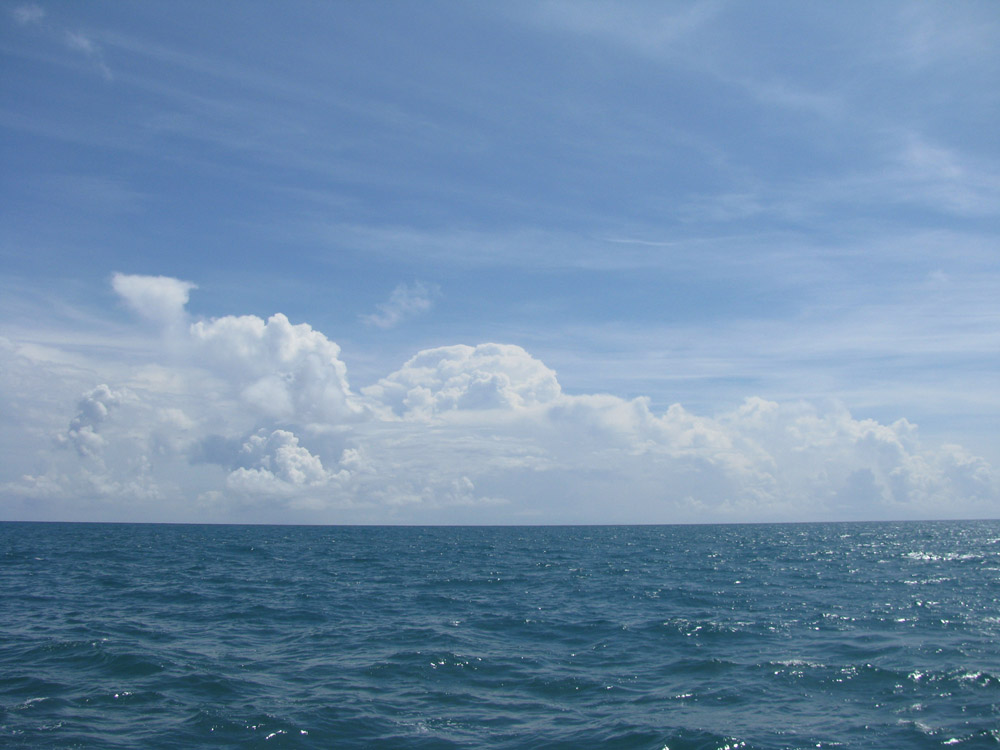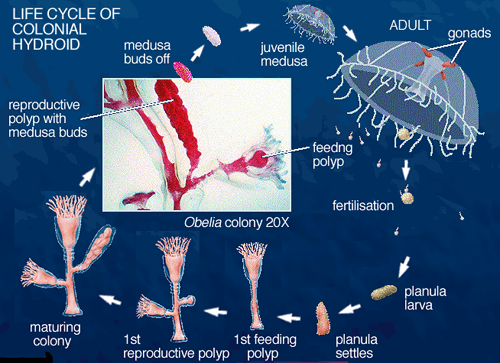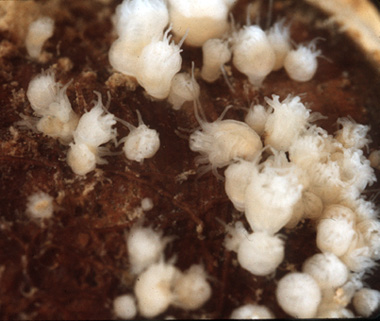Reproduction
Aequorea victoria inhabits the Pacific Ocean just off the northwest coast of the United States (Ormo et al., 1996). Aequorea victoria, just like other jellyfish, have a unique dimorphiclife cycle (fig. 1).
Figure 1. The life cycle of a colonial hydroid is unique
because it is dimorphic. The dimorphic life cycle means that there
are key differences in the morphology between the polypoid colony
and the adult medusa (Aequorea victoria, 1979).
Fully mature jellyfish, which are called medusa, produce either sperm or eggs that fuse together to form a polypoid, which do not resemble a medusa. These polypoids fuse to rocks (For another example of young who fuse and become immotile click here) and begin to reproduce asexually (Aeqorea victoria, 1979). These polyps feed by using tentacles that grab, sting and paralyze microorganisms that float by. The polyps are also either male or female. Certain environmental cues trigger the polyp to form a bud on the side called a gonophore (Aequorea victoria, 1979). The gonophores asexually produce more cells and eventually form a young medusa. When big enough, the forming medusa break off and begin to float off into the ocean (Aequorea victoria, 1979). This cycle happens for several months; periodically the jellyfish reproduce sexually, creating more polyps and continuing the cycle. Aequorea victoria are believed to use environmental cues to reproduce, although they do not know what specific environmental cues trigger the seasonal reproduction (For another example of marine organism that reproduces during a certain season click here) (Mills, 1999). Dr. Shimomura had thousands of jellyfish to study while he was in Washington, but in modern times the population of jellyfish has taken a drastic turn (For more information on the decline, visit habiat by clicking here).
Figure 2. A
colony of Aurelia aurita polyps that are growing together. The polyp
does not resemble the medusa form, but each medusa is the result of
asexual reproduction from the polyp.
Environmental factors are believed to be the leading cause in the reduction of the jellyfish population. Environmental effects such as global warming, decreasing salinity and change in ocean currents could be causing the population to die down (To learn more about the environment that Aequorea victoria live in click here) . Over predation could also be a factor that has reduced the number of jellyfish. When the times are right, they begin to reproduce and require water as the primary medium. Aequorea victoria have an indirect life cycle which means that the larvae look nothing like the adult (For another example of a indirect life cycle click here). The medusae release sperm and eggs into the water and the sperm use the water to swim towards the egg, thus continuing the life cycle. The Aequorea victoria reproduction cycle takes place roughly from April to September (Aequorea victoria, 1979). During this time period, Aequorea victoria jellyfish can often be found in plentiful amounts and can drift from southern California to British Columbia in Canada (Aria, 1986). A big known factor that limits their ability to reproduce and grow is the amount of food that is available to them (Purcell, 1991). The amount of Aequorea victoria have a direct relationship with the amount of prey available; An increase of prey such as zooplankton will cause an increase in the amount of Aequorea victoria (Purcell, 1991) (For inormation on how Aequorea victioria interacts with other organisms click here).
During the life cycle of Aequorea victoria, it has many interactions with other marine organisms. To learn about how Aeqorea victoria interacts with other marine organisms, click the Interactions button at the bottom of the page!


